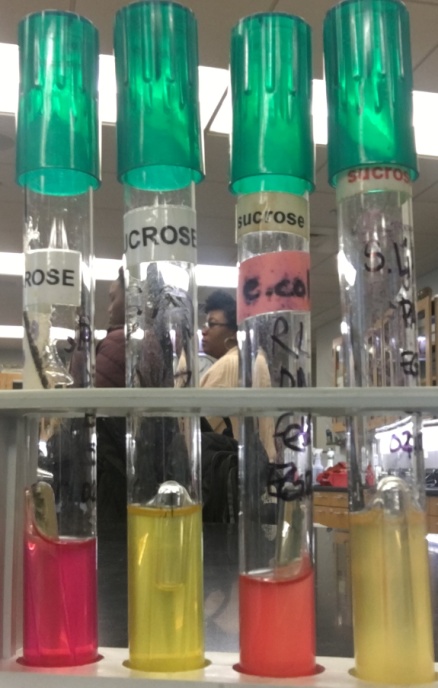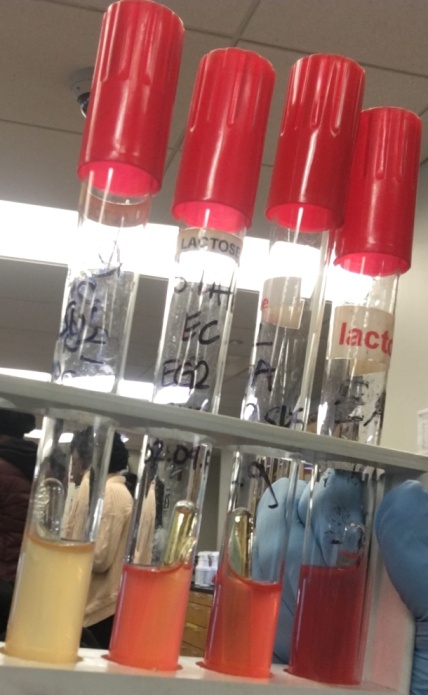Introduction
Escherichia coli is a gram-negative bacterium that resides in the gastrointestinal tracts of humans and animals. Some strains of E. coli cause diseases, primarily diarrhea, while others are safe. Different bacterial strains ferment different carbohydrate sources (Bello, Bello, Egberongbe, Azeez, & Oluwadun, 2013).
Pseudomonas aeruginosa is a gram-negative pathogenic bacterium that demonstrates a high level of antibiotic resistance and causes hospital infections with a high rate of mortality. P. aeruginosa is metabolically changeable and can utilize different sources of carbohydrates (Gellatly & Hancock, 2013).
Proteus mirabilis is a gram-negative bacterium that is a normal inhabitant of the human intestine. However, it can cause infections—in particular, urinary tract diseases. P. mirabilis can use a wide range of carbohydrates (Umar, Yaya, Yusuf, Tafinta, Aliko,& Lawal, 2016).
Enterobacter aerogenes is a gram-negative bacterium that can cause different infections and also demonstrates a high level of antibiotic resistance. For the identification of E. aerogenes through biochemical tests, the phenol red broth test is commonly used (Bello et al., 2013).
Phenol red broth with different sugars is a widely used differential diagnostic microbiological cultural media consisting of water, peptone, phenol red, and one of the following carbohydrates: glucose, sucrose, or lactose. Each test tube with broth contains a Durham tube to identify the production of gas. Phenol red serves as an indicator of pH change as it changes color according to pH level: it turns yellow if the pH of the media falls below 6.8, red if the pH level is between 6.9 and 7.4, and pink if pH is higher than 7.5.
During carbohydrate fermentation, bacteria produce acid and/or gas. While the production of acid changes the color of the media to yellow, gas production is evident when bubbles are observed in a Durham tube. If the bacterial strain is unable to utilize the carbohydrate, it uses peptone and produces ammonia. This process results in an alkaline condition and a pink color of the media (Tortora, Funke, & Case, 2015).
Thus, the purpose of this experiment was to determine the ability of four bacterial species to utilize sucrose, glucose, and lactose by using the phenol red broth test.
Materials & Methods
Before beginning the experiment, the working area was cleaned and disinfected, hands were washed, and gloves were put on. All required materials were obtained and laid out on the working surface. Four bacterial species (E. coli, P. aeruginosa, P. mirabilis, and E. aerogenes) were tested. Three phenol red broth test tubes with glucose, sucrose, and lactose were used for each of the four species, making 12 tubes in total. The Bunsen burner was lit, and the inoculating loop wire was incinerated in the flame until the wire turned orange. The loop was held in the dominant hand, and the plate with colonies of E. coli was partly opened with the second hand. After the inoculating loop had cooled, a small amount of bacterial biomass was taken from the plate. The loop was held within 10 centimeters of the burner flame in one hand, while the plate was closed and the tube with the phenol red broth with the glucose was taken out with another hand. The tube cap was removed with the little finger of the dominant hand, and the tube mouth was incinerated in the flame. The bacterial biomass was inoculated in the tube with broth. After that, the tube mouth was incinerated in the flame again and the cap was replaced to close it. The loop was incinerated in the flame. This exact procedure was repeated with the tubes containing sucrose and lactose. The three test tubes were signed. This procedure was repeated with each of the other three species of bacteria. All inoculated test tubes were incubated for 24 hours at 37ºC under aerobic conditions. After that, the results of the experiment were analyzed.
Results
Figure 1 depicts the results of the experiment for all four species of bacteria, cultivated in test tubes with the sucrose and lactose broths. It could be observed that bacterial suspensions emerged in tubes, broth changed its color, and gas appeared in Durham tubes.


The complete results of the experiment are presented in Table 1. A significant difference between the species that utilize and do not utilize glucose, sucrose, or lactose is evident. After incubation, the characteristics of biochemical bacterial species are expressed in the differing broth colors and the presence or absence of air bubbles in the Durham tubes.
Table 1
The Results of the Phenol Red Broth Test
Discussion
In general, the results of the experiment conform to data in the existing literature. Based on the obtained data, it can be postulated that E. coli utilizes glucose and lactose but does not utilize sucrose. It is known that different strains of this bacterium demonstrate different biochemical characteristics. Sucrose-positive and sucrose-negative strains can be isolated from the environment as well as from human or animal intestines (Bello et al., 2013).
P. aeruginosa in this experiment was able to utilize all carbohydrates, leading to acid and gas production in each case. This result agrees with the well-known ability of this bacterium to utilize a wide range of carbon sources (Tortora et al., 2015).
Unlike E. coli and P. aeruginosa, the data obtained for P. mirabilis do not agree with the literature data regarding sucrose. According to the literature (Umar et al., 2016), this bacterium can utilize sucrose, while in the lab experiment, the result for the phenol red broth with sucrose was negative. The broth remained clean, and no visible marks of bacteria growth were observed. A possible mistake during the inoculation procedure could explain this contradiction. A negative result of the lactose test and a positive result of the glucose test agree with the literature (Umar et al., 2016).
In this experiment, E. aerogenes demonstrated the ability to utilize all three tested carbohydrates. In the lactose test, the color of the media remained red; however, gas production was observed. It could be possible that the process of lactose utilization was slow and that the level of produced acid was too low to change the color of the pH indicator (Tortora et al., 2015). These results agree with the biochemical characteristics of E. aerogenes in the literature (Bello et al., 2013).
As demonstrated by this experiment, biochemical tests are very important for bacterial differentiation. The phenol red broth test is one of the most widely used methods of determining biochemical characteristics. In this experiment, the different growing abilities of four bacteria species on the media were demonstrated.
References
Bello, T. K., Bello, O. O., Egberongbe, H. O., Azeez, I. A., & Oluwadun, A. (2013). Antibiotics resistance profile of Escherichia Coli and Enterobacter Aerogenes isolated from well waters in Ago-Iwoye, Southwestern Nigeria. Journal of Advances in Biology, 2(2), 135–144.
Gellatly, S. L., & Hancock, R. E. (2013). Pseudomonas aeruginosa: New insights into pathogenesis and host defenses. Pathogens and disease, 67(3), 159–173.
Tortora, G. J., Funke, B. R., Case, C. L., & Johnson, T. R. (2004). Microbiology: an introduction (Vol. 9). San Francisco, CA: Benjamin Cummings.
Umar, M., Yaya, A. A., Yusuf, G., Tafinta, I. Y., Aliko, A. A., Jobbi, D. Y., & Lawal, G. (2016). Biochemical characterization and antimicrobial susceptibility trends of Proteus mirabilis isolated from patients suspected with urinary tract infections attending Sickbay Hospital, Zaria, Kaduna, Nigeria. Annals of Biological Sciences, 4(2), 1-8.